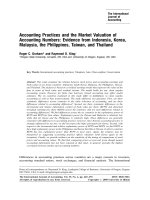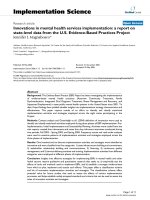Strategic Six Sigma-Best Practices From The Executive Suite
Bạn đang xem bản rút gọn của tài liệu. Xem và tải ngay bản đầy đủ của tài liệu tại đây (1.26 MB, 339 trang )
STRATEGIC
S
IX
SIGM
A
BEST PRACTICES FROM THE
EXECUTIVE SUITE
Dick Smith and Jerry Blakeslee
with Richard Koonce
J
OHN
W
ILEY
& S
ONS
, I
NC
.
STRATEGIC
SIX
SIGM
A
STRATEGIC
S
IX
SIGM
A
BEST PRACTICES FROM THE
EXECUTIVE SUITE
Dick Smith and Jerry Blakeslee
with Richard Koonce
J
OHN
W
ILEY
& S
ONS
, I
NC
.
Copyright 2002 by PricewaterhouseCoopers LLP. All rights reserved.
Published by John Wiley & Sons, Inc., Hoboken, New Jersey.
Published simultaneously in Canada.
Six Sigma is a registered trademark of Motorola, Inc. Use of the spelling
“6 Sigma” for Six Sigma occurs in this book when referencing Caterpillar’s
use of the methodology.
No part of this publication may be reproduced, stored in a retrieval system
or transmitted in any form or by any means, electronic, mechanical,
photocopying, recording, scanning or otherwise, except as permitted under
Sections 107 or 108 of the 1976 United States Copyright Act, without either the
prior written permission of the Publisher, or authorization through payment
of the appropriate per-copy fee to the Copyright Clearance Center, Inc., 222
Rosewood Drive, Danvers, MA 01923, (978) 750-8400, fax (978) 750-4470, or
on the web at www.copyright.com. Requests to the Publisher for permission
should be addressed to the Permissions Department, John Wiley & Sons, Inc.,
111 River Street, Hoboken, NJ 07030, (201) 748-6011, fax (201) 748-6008,
e-mail:
Limit of Liability/Disclaimer of Warranty: While the publisher and
author have used their best efforts in preparing this book, they make no
representations or warranties with respect to the accuracy or completeness
of the contents of this book and specifically disclaim any implied warranties
of merchantability or fitness for a particular purpose. No warranty may be
created or extended by sales representatives or written sales materials.
The advice and strategies contained herein may not be suitable for your
situation. The publisher is not engaged in rendering professional services,
and you should consult a professional where appropriate. Neither the
publisher nor author shall be liable for any loss of profit or any other
commercial damages, including but not limited to special, incidental,
consequential, or other damages.
For general information on our other products and services please contact
our Customer Care Department within the U.S. at (800) 762-2974, outside the
United States at (317) 572-3993 or fax (317) 572-4002.
Wiley also publishes its books in a variety of electronic formats. Some
content that appears in print may not be available in electronic books.
ISBN 0-471-23294-7
Printed in the United States of America.
10987654321
If you think about Six Sigma as another quality program, then it deserves
as much intensity as all the other initiatives that can go on in a big
company. [But] to the degree that you see Six Sigma as a culture
changer—something that will profoundly affect the organization—then
by definition, it takes the passion and obsession of the CEO to make it
happen. We saw Six Sigma—and by the way we call it Raytheon Six
Sigma—as a way to profoundly change our culture, and therefore it
started with me and ends with me. I include language on it at almost
every meeting that I have, to the extent that people’s lips almost move
in synch with mine on this subject.
—Dan Burnham, Chairman and CEO
Raytheon Corporation
Contents
Acknowledgments ix
Introduction: From Factory Floor to Executive Suite: The Emergence
of Strategic Six Sigma as a Business and Leadership Imperative xiii
Chapter 1 Strategic Six Sigma: Current and Emerging
Applications 1
Chapter 2 Rocky Road or Trajectory of Transformation?
What Makes Strategic Six Sigma Efforts Successful? 39
Chapter 3 Develop a Committed Team of Leaders to Drive
Strategic Six Sigma Initiatives 65
Chapter 4 Incorporate Strategic Six Sigma Thinking and Best
Practices into Your Company’s Strategy Planning
and Deployment Process 93
Chapter 5 Be in Touch with Customers and the Marketplace 119
Chapter 6 Build a Business Process Framework to Sustain
Strategic Six Sigma Efforts 149
Chapter 7 Demand Quantifiable Results 173
Chapter 8 Develop Incentives and Create Accountability 201
Chapter 9 Success with Strategic Six Sigma Projects Requires
Full-Time, Well-Trained Six Sigma Leaders 221
vii
Chapter 10 Why Training Is Critical to Making Strategic Six Sigma
Initiatives Work 239
Chapter 11 Sustaining Gains with Strategic Six Sigma over Time 261
Afterword: Some Parting Thoughts 281
Notes 285
Credits 291
Bibliography and Recommended Reading 295
About the Authors 299
Index 303
viii Contents
➤
Acknowledgments
Writing a book, as you might imagine, is a highly collabora-
tive endeavor. It is an intense, creative, and interactive enter-
prise from initial thoughts to finished text. For that reason,
we want to recognize the many friends, clients, and col-
leagues, without whose constant involvement and steady
interest Strategic Six Sigma: Best Practices from the Executive
Suite, would not have been written.
To our clients and friends who so willingly shared their
stories of leadership, change, and transformation with us, we
are extremely grateful for your participation in this project.
At Dow Chemical, special thanks to Mike Parker, Kathleen
Bader, Tom Gurd, Darlene MacKinnon, Jeff Schatzer, Matt
Rassette, Shelly Bartosek, and Nancy Weiss. At Caterpillar, our
gratitude to Glen Barton, Dave Burritt, Geoff Turk, Julie Ham-
mond, Denny Huber, Diana Shankwitz, Jill Keel, and Phil
Thannert. At Bombardier Transportation, our appreciation to
Pierre Lortie, Desmond Bell, and Marlene Girard. At Service-
Master, Jon Ward, Phil Rooney, Pat Asp, and John Biedry. At
Raytheon, Dan Burnham, David Polk, and Ann Psilekas. At
Air Products & Chemicals, George Diehl. At Lockheed Martin,
our thanks to Mike Joyce and Shirley Pitts. And at J.P. Mor-
gan Chase, our appreciation to Debbie Neuscheler-Fritsch.
At PricewaterhouseCoopers, we gratefully acknowledge
the assistance of a number of key colleagues including: Grady
ix
Means, Bill Trahant, Joe DeVittorio, Warner Burke, Steve
Yearout, Jim Prendergast, Monica Painter, David Wilkerson,
Cathy Neuman, Jim Niemes, Tom McElwee, Charlie Streeter,
Peter Amico, George Byrne, Steve Marra, Dan Arnott, Bob
Norris, Dawn Edmiston, Mary Trotter, Teddy Regio, Shruti
Chandra, Rita Thomas, Bertha Ballard, Robin Masinter,
Yolanda Ortiz, Don McCartney, and Allyson Woodruff. This
book is incalculably richer for the comments, insights, and
ideas each of you suggested as we proceeded with the writing
of the manuscript.
To our agent Doris Michaels of the Doris Michaels Liter-
ary Agency in New York, and our editor, Matt Holt at John
Wiley & Sons. We are grateful for your support of and stead-
fast interest in this project, and for your continuing advice
and counsel as we prepared the manuscript for publication.
To our friends at The American Society for Training &
Development and at T & D magazine, including Pat Galagan,
Haidee Allerton, Valerie Small, Mark Morrow, and Tresa Sul-
livan; and at the Journal of Organizational Excellence (JOE),
Jane Bensahel and Mary Ann C. Fusco. We thank you all for
the opportunities you gave us in the past to publish our ideas
about Strategic Six Sigma in your publications. Many of
those ideas have been further developed, refined, field-tested,
and presented in this book, as insights and approaches from
which we hope others will learn.
To Roxanne O’Brasky and her colleagues at the Interna-
tional Society of Six Sigma Professionals in Scottsdale, Ari-
zona: Thank you for your interest and involvement in
supporting this project.
To Tim Jubach, an independent consultant and president
of Lean Enterprise, Inc. Thanks for your help in arranging
the Raytheon interview.
x Acknowledgments
➤
To our friends at Video-on-Location in Rockville, Mary-
land, who gave us invaluable assistance in producing the
video interviews on which much of the book’s text was based,
and which have been subsequently produced, in CD-ROM
form, as a leadership training tool (and companion) to
Strategic Six Sigma: Best Practices from the Executive Suite. In
particular, we want to acknowledge the involvement of Dino
Veizis, Jim Veizis, Alex Veizis, Jerry Moxley, Chris Houck,
and Henry Heuscher. Thanks guys!
To our collaborator and friend, Rick Koonce, who was
continually challenged to collect and integrate our thoughts
on Strategic Six Sigma based on countless cell phone calls,
meetings, hallway discussions, and e-mails. Thanks, Rick, for
helping us to produce a smooth-flowing, reader-friendly text
from which CEOs and other senior leaders will undoubtedly
gain insights and learnings that they can use to implement
Strategic Six Sigma in their own organizations!
To our families, especially our wives, Bonnie and Nancy,
who have patiently put up with years of us being on the road
for business week after week. We are humbly indebted to you
both, for all you do.
Finally, we want to thank you, our readers. We hope that
you find Strategic Six Sigma to be a valuable tool that you can
use to introduce Strategic Six Sigma thinking and best prac-
tices into your organization. Please feel free to contact us at
the e-mail addresses included in the book’s introduction.
We’d enjoy hearing from you, and learning what you your-
selves have learned from introducing Strategic Six Sigma in
your company.
Dick Smith and Jerry Blakeslee
Acknowledgments ➤ xi
Introduction: From Factory
Floor to Executive Suite:
The Emergence of Strategic
Six Sigma as a Business and
Leadership Imperative
Six Sigma, the highly statistical quality improvement tech-
nique born in the manufacturing bays of Motorola in the
mid-1980s, is often used at an operational level inside com-
panies today to help them cut costs, improve processes, and
reduce business cycle times. Its value in this regard is well
understood by business leaders today, and has been the
topic of numerous business books and articles in recent
years.
Less well known, however, is the potential of Six Sigma to
serve as a means to help companies formulate and deploy
their business strategies, and bring about broad-gauge trans-
formational change—to serve, in other words, as a high-order
leadership approach, philosophy, and change methodology.
Strategic Six Sigma principles and practices can, for exam-
ple, be used to help companies:
xiii
➤ Formulate, integrate, and execute new (or existing)
business strategies and missions
➤ Deal with constantly changing (and increasingly
complex) customer requirements
➤ Accelerate a company’s globalization (and global
integration) efforts
➤ Facilitate mergers and acquisitions (Dow’s merger
with Union Carbide, for example)
➤ Ensure effective implementation of e-business ven-
tures with their associated strategies and infrastructure
➤ Drive revenue growth
➤ Accelerate innovation
➤ Improve marketing channels
➤ Enhance and condense the corporate learning cycle—
the time it takes to translate market intelligence and
competitive data into new business practices
➤ Win the customer care war
➤ Drive systemic and sustainable culture change
➤ Improve financial and corporate reporting
➤ Manage and mitigate business risk
■
A VEHICLE FOR DEPLOYING
CORPORATE STRATEGIES
A growing number of companies today are beginning to real-
ize the full, strategic implications of Six Sigma, especially as
an engine to accelerate corporate strategy and organizational
transformation. Former General Electric (GE) CEO Jack
Welch, for example, says that Six Sigma has forever “changed
the DNA” of how GE operates. Before his first retirement as
Honeywell’s larger-than-life CEO, Larry Bossidy used to tell
Honeywell employees and shareholders alike that Six Sigma
was the key to Honeywell realizing annual 6 percent gains in
xiv Introduction
➤
productivity “forever.” At Citibank, meanwhile, Six Sigma was
recently implemented to accelerate the bank’s customer care
approaches around the world. Du Pont and Dow Chemical are
both using it to propel sustainable growth, and to position
themselves in an industry notorious for both static product
prices and thin operating margins. Even hotel chains, like
Starwood Hotels and Resorts, are employing it to overhaul
their corporate culture, create blissful customer service expe-
riences for travelers, and to radically alter the nature of their
hospitality services. (See the sidebar, “What Is Sigma?”)
The potential of Strategic Six Sigma to serve such transfor-
mational purposes (and others) has profound implications
for today’s CEOs and their top leadership teams. A recent story
in Fortune noted that one of the biggest causes of business fail-
ures today is the inability of companies to effectively execute
their strategies. Because Six Sigma methodology, at its core,
relies on the use of factual data, statistical measurement tech-
niques, and robust feedback mechanisms to drive decision
making, it’s able to unify top leadership teams behind a com-
mon language (and a set of data points), making strategic
planning and execution more efficient and successful.
Because it aligns a company’s people and processes behind
commonly agreed-to goals, it helps companies achieve
entirely new levels of profitability and corporate performance
Introduction ➤ xv
WHAT IS SIGMA?
In the world of Six Sigma companies, the term sigma has
come to signify how well a business process, product, or serv-
ice is meeting the requirements of the marketplace. Six Sigma
has come to mean failing to meet a customer requirement
only 3.4 times out of a million opportunities.
in less time than traditional strategy implementation does.
And because Strategic Six Sigma increases a company’s focus,
speed, and organizational resilience, it helps organizations
respond quickly to changing market conditions, move in new
business directions, and improve customer responsiveness,
thus enhancing customer relationships, while increasing
shareholder value. (See the sidebar, “Six Sigma in Brief: A Cat-
alyst for Change at the Transformational and Operational
Levels of an Organization.”)
xvi Introduction
➤
SIX SIGMA IN BRIEF: A CATALYST FOR CHANGE AT
THE TRANSFORMATIONAL AND OPERATIONAL
LEVELS OF AN ORGANIZATION
Six Sigma is a high-performance, data-driven approach to
analyzing the root causes of business problems and solving
them. It ties the outputs of a business directly to marketplace
requirements. (See Figure I.1) At the strategic, or transforma-
tional, level, the goal of Six Sigma is to align an organization
keenly to its marketplace and deliver real improvements
(and dollars) to the bottom line. Strategic Six Sigma
approaches provide a framework that potentially can be used
to bring about large-scale integration of a company’s strate-
gies, processes, culture, and customers to achieve and sustain
breakaway business results.
Defects
Market
Variation in the Output of
Processes Causes Defects—
A Defect Is a Failure to Meet a
Critical Customer Requirement
Root-Cause Analysis of
Defects Leads to Permanent
Defect Reduction
Suppliers
Inputs
Business
Process
Process
Outputs
Critical
Customer
Requirements
Figure I.1 Six Sigma business improvement.
■
STRATEGIC SIX SIGMA GENERATES
RESULTS ACROSS MANY INDICATORS
In companies where Strategic Six Sigma has been imple-
mented (Dow, Caterpillar, Raytheon, Bombardier, Lock-
heed Martin, etc.), it has radically and quickly improved
business performance across a wide family of performance
indicators—in everything from return on assets (an inter-
Introduction ➤ xvii
At the operational or process level, Six Sigma’s goal is to
move business product or service attributes within the zone of
customer specifications and to dramatically shrink process
variation—the cause of defects that negatively affect customers.
(See Figure I.2) It provides specific tools and approaches
(process analysis, statistical analysis, lean techniques, root-
cause methods, etc.) that can be used to reduce defects and dra-
matically improve processes to increase customer satisfaction
and drive down costs as a result. (See Figure I.2)
Product or Service Output
Critical Customer Requirement
Defects: Service
unacceptable to
customer
BA
Figure I.2 Six Sigma reduces variation in business
processes. An objective of Six Sigma is to reduce variation
and move product or service outputs permanently inside
customer requirements (curve A to B).
nal business indicator) to customer satisfaction and timely
order fulfillment (external performance metrics.)
Just what’s driving the transmutation of Six Sigma from
process improvement technique into an accelerator of busi-
ness strategy and implementation, and a tool of organiza-
tional transformation? To answer that question, one needs
only to look at the rapidly changing nature of today’s busi-
ness environment and the multiple drivers and pressures
that are exerting themselves on the daily operations of com-
panies. Today, for example, companies are under more pres-
sure than ever to:
➤ Develop, implement, and often rapidly revise their
business strategy
➤ Attract, service, and retain customers (often by antic-
ipating their needs before they do)
➤ Globalize business operations
➤ Accelerate innovation and research and development
(R&D)
➤ Redesign their sales and marketing channels rapidly
➤ Manage business risk
➤ Develop and introduce new products and services
faster and more efficiently
➤ Build national and global brands
➤ Develop and implement effective supply chains
➤ Implement transformational change
A recent survey of corporate CEOs commissioned by the
Foundation for the Malcolm Baldrige National Quality
Award confirms this.
1
The study identified a number of sig-
nificant trends that are exerting a transformational influ-
ence on the nature of global business today. All of them have
profound implications for the productivity and profitability
xviii Introduction
➤
of companies worldwide. For example, of the more than 300
CEOs who answered the survey:
➤ Ninety-four percent cited globalization as a major
trend impacting the life and livelihood of companies
today. Yet, only 18 percent of respondents rated major
U.S. companies as excellent in dealing with this
trend.
➤ Eighty-eight percent of survey respondents said that
improving knowledge management was critical to
their business operations. Yet, only 23 percent rated
major U.S. companies as excellent in this category.
➤ Seventy nine percent of CEOs polled in the survey
rated cost and cycle time reduction as a major need
and trend in their companies today. Yet, only 31 per-
cent indicated that U.S. companies, in their view, do
an excellent job at these activities.
Still other major trends and issues identified by respon-
dents as critical to business operations today included:
1
➤ Improving global supply chains (78 percent)
➤ Manufacturing at multiple locations in many coun-
tries (76 percent)
➤ Developing new employee relationships based on
performance (69 percent)
➤ Improving the execution of strategic plans (68 per-
cent)
➤ Developing more appropriate strategic plans (64 per-
cent)
➤ Ensuring effective measurement and analysis of orga-
nizational processes (60 percent)
Introduction ➤ xix
Any company’s performance, of course, is closely related
to corporate leadership—and to specific leadership compe-
tencies. Thus, another interesting cluster of findings to
emerge from the Baldrige survey pointed to the fact that in
many cases today, business leaders view themselves as lack-
ing certain key competencies, and in need of upgrading
others. Over half of the CEOs in the Baldrige survey, for
example, believe that they (and their peers) need to improve
their skills in the following areas “a great deal.”
1
➤ The ability to think globally—72 percent
➤ The ability to execute strategies successfully—66 per-
cent
➤ Flexibility in a changing world—63 percent
➤ The ability to develop appropriate strategies—60 per-
cent
➤ The ability to rapidly redefine their business—54 per-
cent
➤ Understanding new technologies—52 percent
➤ The ability to work well with different stakeholders—
50 percent
➤ Creating learning organizations—49 percent
1
What’s the common thread running throughout all these
survey findings?
■
IMPROVING PERFORMANCE IS A
UNIVERSAL BUSINESS PRIORITY
First, all of them have implications for a company’s ability
to compete effectively in an increasingly brutal business
environment. They suggest that companies (and their lead-
ers) today need to focus on improving business performance
xx Introduction
➤
both at a process level (the level of actual, everyday work)
and at a much higher organizational level as well—the level
of strategy development, planning, and deployment.
Second, the findings suggest that companies today are in
need of a strong strategic framework and language, not only
to help them define their vision and articulate their mission,
but also to define, measure, analyze, and improve their per-
formance whether the specific goal is to build market share,
enhance customer loyalty, accelerate the R&D process, or
improve shareholder value.
Six Sigma principles and approaches—and especially
those that are applied in a systematic and strategic way as we
describe in this book—can have a tremendous impact both
on a company’s bottom-line business performance and on
its potential for true, top-line business growth. Why? Because
the statistically rigorous and robust approaches to business
improvement that Six Sigma principles embody provide
companies with a common vehicle and language with which
to frame business goals, align people and processes, focus
organizational energy, and drive results. Six Sigma tools and
concepts provide a means to optimally align all of an orga-
nization’s components—from leaders, culture, and mission
and strategy on the one hand, to structure, management prac-
tices, systems, work climate, and employee skill sets and behav-
iors on the other—to help a company achieve breakthrough
levels of business performance. These variables, as change
consultant and author W. Warner Burke puts it, represent the
full range of “transformational and transactional” drivers at
work in any organization today, and therefore constitute the
full productive potential of any business enterprise.
We refer to companies that effectively employ Strategic
Six Sigma as market-smart. That’s because they typically
share a number of crucial characteristics: a well-developed
Introduction ➤ xxi
(yet constantly revisited) business strategy; a laserlike focus
on customers; and a strong internal climate of alignment to
support strategic business goals.
Because Strategic Six Sigma practices are necessarily
built on a foundation of knowledgeable and committed lead-
ers, beginning with the CEO and cascading down throughout
all levels of the organization, we have titled this book, Strate-
gic Six Sigma: Best Practices from the Executive Suite. Within
its pages, we’ve attempted to capture key insights, anecdotes,
wisdom, and stories gathered from interviews conducted
with many of today’s most successful business executives—
people who’ve both discovered and leveraged the benefits of
Strategic Six Sigma thinking and best practices inside their
own organizations.
In Strategic Six Sigma: Best Practices from the Executive
Suite, our goal is to outline the key elements of Strategic Six
Sigma leadership in companies today, and to provide readers
with the guideposts necessary to apply these same practices
and approaches in their own companies. To that end, the
book is divided into three sections.
Part 1 (Introduction, Chapters 1 and 2) focuses on why
every company today needs to become a market-smart com-
pany if it is to survive in the marketplace, build customer
loyalty, and provide high-quality products and services to
customers. We look at the tyranny of environmental forces
at work in the business environment today that are com-
pelling companies of all kinds (and in all industries) to
develop increasingly robust approaches to ensuring high
performance, and how market-smart companies do this
through effective implementation of Strategic Six Sigma
within their businesses. We also delve in-depth into the com-
pelling strategic mega-applications of Strategic Six Sigma
that are emerging as part of leadership practice in market-
smart companies today.
xxii Introduction
➤









